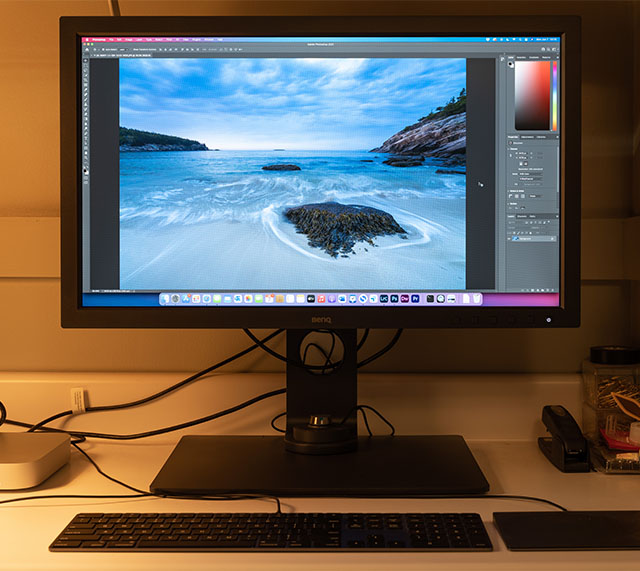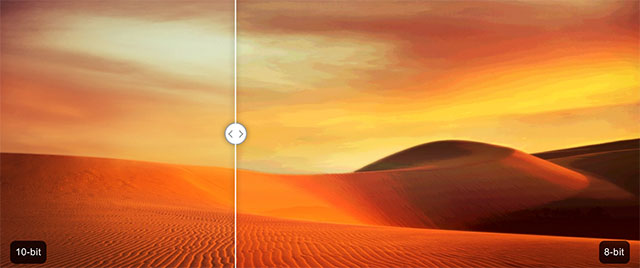BenQ PhotoVue SW271C 4K HDR Monitor Review: An expensive but excellent monitor for photo editing
posted Thursday, June 10, 2021 at 1:45 PM EST

In early March, BenQ announced the PhotoVue SW271C 4K HDR monitor, the successor to the SW271. The new monitor comes equipped with numerous updates to features and performance, but it also comes with a $500 price increase. At $1,600, the BenQ SW271C is an expensive 27" IPS monitor. That said, after spending the last couple of months using the display, it's obvious that it offers excellent build quality, performance, and an impressive array of features. But is it worth its steep asking price? Let's find out.
BenQ SW271C 27" 4K HDR Monitor Key Features
- 27" IPS display
- 3840 x 2160 resolution at 60 Hz refresh rate
- 300 cd/m2 brightness
- 5 ms response time
- 1,000:1 contrast ratio
- 99% Adobe RGB, 100% sRGB and 90% DCI-P3 coverage
- 10-bit support for 1.07 billion colors
- 16-bit LUT support
- 178° viewing angle in portrait or vertical orientation
- Includes Hotkey Puck G2 for various physical controls over the monitor
- Includes DisplayPort 1.4, HDMI 2.0, USB Type-C inputs
- Has a USB 3.0 Hub and SD card reader
- Can charge notebooks with USB power delivery (60W)
- $1,599 USD
Set-up, design and usability
Some assembly is required to get the monitor up and running, but it's straightforward, and the included instruction manual and quick-start guide proved helpful. You don't need any tools to put the monitor together. The monitor itself is packaged separately from the large heavy-duty monitor base and the arm that connects the monitor to the base. It took me probably 15 minutes to get everything unpacked and put together.

Once assembled, the monitor looks very much like the SW271, including the same dark gray plastic and large bezels. I don't personally mind large bezels around a computer display, but the resulting look isn't exactly modern. The stand offers considerable adjustability, both in terms of height and importantly, in terms of tilting the display. Further, you can also use the display in landscape or portrait orientation.

The Hotkey Puck G2 is great. It sits in a small indent on the base of the monitor and has numerous programmable buttons. You can switch between color spaces, adjust volume, change brightness, contrast, switch inputs and more. The G2 has a center dial you can rotate to adjust settings, and it allows you to click, confirming menu navigation. There are also controls on the monitor itself. Running underneath the display along the right side are buttons for changing inputs, accessing menus and powering on the display.

Performance and calibration
While BenQ markets the SW271C monitor as an HDR display, it's a bit more complicated than that. The display has a maximum brightness of only 300 cd/m2 (referred to as nits from now on), which is not HDR territory. An HDR television, for example, could have a maximum brightness eclipsing 1,000 nits. At 300 nits, you're not going to get an accurate picture of HDR video on the SW271C compared to a bright HDR TV. You can't see the same brightness on this BenQ display, even in HDR, as you would see on an HDR TV, and it would be very hard to edit an HDR video without access to a larger chunk of the tonal range of HDR formats.
I asked BenQ about the display's HDR capabilities, and BenQ said the following, 'The monitor is able to support HDR Curve (PG/ HLG), but it is not an HDR reference monitor. What we're trying to deliver to the users is the color accuracy, uniformity, graphic quality. High Brightness may impact the performance of the items I mentioned. Therefore, we stick to deliver what's most important to our main target audience, photographers. Take EIZO CG319X as [an example], it's an HDR video editing and color-accurate photo display but the brightness is 350nits as well.'

It's important to zero in on an important statement in that quote, that the target market of the monitor remains photographers. The SW series is aimed at photographers. The SW271C's inclusion of video-friendly features is because the role of the photographer has changed since the original SW271 released. Demand has changed, and photographers do more video editing, so BenQ worked hard to include additional features which will appeal to hybrid shooters.
Is the SW271C a 'true' 10-bit display? No, it's an 8-bit display that uses Frame Rate Control (FRC) to switch between displaying different 8-bit color values quickly. It's not exactly a 10-bit display, then, but it sort of is in the sense of how many colors it can display.

I reached out to BenQ to clarify how the SW271C displays 10-bit color, which is 1.07B colors. I also asked about using an 8-bit + FRC panel rather than a true 10-bit panel. There are multiple ways a monitor can display 10-bit color, including through being a true 10-bit panel (but it's costly) and using 8-bit + FRC. The SW271C uses the latter approach because it's more cost-effective and difficult to see any difference between 8-bit + FRC versus true 10-bit except for in very limited situations. Compared to an 8-bit panel without FRC, the SW271C promises eight times the color display capabilities and reduced banding issues. Further, a true 10-bit panel may sacrifice in other areas to achieve its color performance, including light uniformity and gamut coverage ratio. After evaluating its panel options, BenQ opted to use 8-bit + FRC.
Although marketing claims of 10-bit color and HDR performance may not tell the entire story, the monitor delivers on its promise of excellent color gamut coverage, accuracy, and Delta E. It's a very accurate display with excellent performance.
The SW271C uses edge lighting but I didn't notice any issues with inconsistent brightness across the display, beyond what's to be expected since it's practically impossible to have a perfectly uniform display. Further, color performance is very impressive. Out of the box, the monitor looked great when editing photos, but after calibrating the monitor, it improved further. It's a very sharp, vibrant monitor.

The monitor includes built-in Uniformity Technology, which works very well. If you're editing HDR video, you'll want to disable this feature, at least temporarily, but for editing SDR video and photos, it's well worth using. There are hundreds of sub-regions on the display, which are regularly measured and adjusted using algorithmic software to ensure a consistent image across the display. You can learn more about this technology here.

Calibration is very simple. I used a Datacolor SpyderX and BenQ's software. It takes only a few minutes to calibrate the display, and the software will remind you when it's time to recalibrate later on. If you want a consistent workflow, especially if you're doing any printing, I highly recommend calibration. BenQ makes it easy. The SW271C is compatible with the latest calibrators from X-Rite and Datacolor, including the X-Rite i1 Display Pro and Datacolor Spyder X. The monitor can also be calibrated with some older models. To learn more about calibrating the SW271C, check out this step-by-step guide from Image Science.

To sum this section up, the BenQ SW271C is an excellent monitor for photographers, even those who work with video, although an HDR-heavy workflow will require a different monitor. The monitor is sharp, vivid, and displays great colors. It's easy to calibrate to your specific workflow, as well, which is important to me.
BenQ SW271C Monitor Review Summary
What I like:
- Very good performance
- Great color gamut coverage
- Impressive build quality
- Built-in SD card slot and USB power delivery
- HotKey Puck G2 control works well
- Easy set up and easy calibration
- Good set of features, including Paper Color Sync
What I dislike:
- Not a true 10-bit panel
- HDR limited to 300 cd/m^2 brightness
- Heavy monitor with a large bezel
- Expensive
The BenQ SW271C is an excellent monitor for photographers. It offers very good performance, and it has a great panel.
It's not all great news, however, as the monitor has an outdated look and is quite large and heavy. The monitor includes more video features than its predecessor but is still unlikely to fit the bill for demanding video editors. Although, ultimately, that's not the market that BenQ is targeting with its SW series. Further, perhaps the biggest downside is its price. The SW271C is $1,600, which is a full $500 more than the original SW271, which is still a great option for photographers. There are many more expensive monitors than the SW271C, of course, but there are also many that are more affordable.

Where does this leave the BenQ SW271C? Ultimately, it's a great monitor for photo editing. It's not the most sleek or stylish, but its performance is excellent. The monitor has plenty of ports, features and performance to make it a great choice.
BenQ provided a review sample of the BenQ SW271C for the purposes of this review. BenQ had no editorial input, nor was any form of compensation received from BenQ for this review.